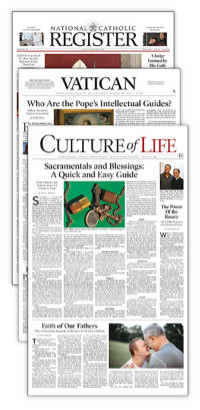Apostolic Constitution on Cloistered Nuns: The Old Is New

MOTHER ANGELICA’S MONASTERY. A memorial Mass in honor of Mother Mary Angelica of the Annunciation, foundress of EWTN Global Catholic Network, at the Shrine of the Most Blessed Sacrament on March 29. Mother Angelica died on March 27, 2016. Jeff Bruno/EWTN
Flemington, N.J. — A new apostolic constitution on cloistered nuns from Pope Francis has been met with some confusion and speculation about what it really means for nuns who live the cloistered life.
The document, titled Vultum Dei Quaerere (Seek the Face of God), which was released by the Vatican on July 22, replaces the previous apostolic constitution regulating cloisters, Sponsa Christi, which was issued by Pope Pius XII in 1950.
Almost immediately, questions arose about the document’s meaning and purpose. Some commentators suggested that the Vatican was trying to take over women’s religious orders, impose onerous new rules on the sisters and close down monasteries.
The international weekly The Tablet ran a headline indicating Pope Francis was conducting an “overhaul of female religious life” and claimed “there are hundreds of thousands of contemplative nuns across the world” who would be impacted.
In reality, there are about 700,000 women religious in the world, but most of them are in apostolic orders that perform their ministries out in the world. Only a small percentage of sisters are cloistered, meaning nuns who lead a life of prayer and contemplation and rarely leave their monasteries. The new apostolic constitution applies only to those cloistered nuns.
One of those nuns, Carmelite Sister Gabriela, told the Register that she could speak only for her own experience and her own monastery, The Carmel of Mary Immaculate and St. Mary Magdalen in Flemington, N.J. Her sisters’ reaction to the document — which was read to all the nuns in the monastery — was “definitely positive,” she said, and the nuns are looking forward to getting the specifics in a document to come from the Congregation for Institutes of Consecrated Life and Societies of Apostolic Life (CICLSAL).
She explained that there was very little new in the document and that it seemed to be Pope Francis’ response to issues brought up by the 400 cloistered nuns who were invited to the January Rome gathering to celebrate the close of the Year of Consecrated Life. For example, formation was a topic stressed by Pope Francis in the new document, and Sister Gabriela noted that formation had been “a major concern” that religious voiced to the CICLSAL in response to the questionnaire.
Sister Gabriela explained that the need for good formation, plus the difficulty for many modern young people to make a commitment and trust authority, no doubt prompted a change in which the Pope raised the required number of years in formation before final vows from a minimum of six years to nine years.
Another change to the legislation for cloisters was his directive for individual monasteries to join federations or associations with other monasteries in their same spiritual tradition. Sister Gabriela’s Carmel belongs to The St. Joseph Association of Discalced Carmelite Nuns, which has 12 member monasteries. There are four Carmelite federations in the United States and 60 Carmel monasteries of nuns in this country, she said.
Since cloistered nuns rarely venture out to meetings, Sister Gabriela said these associations or federations provide spiritual and mutual support, understanding in living the charism, and shared resources, such as conferences, formation materials and even personnel or financial need if necessary. These federations also help the CICLSAL keep in touch with the 6,000 monasteries of contemplative nuns around the world.
“Also, it’s essentially to have a way to live communion,” Sister Gabriela said. “Because of [the] cloister, we can very easily get caught up in an ‘ivory tower’ mentality, and that’s addressed in the document. Isolation is not good, and so the federation reminds us that we belong to a greater communion, even in our own community.”
The Register asked Sister Gabriela about fears expressed by some people that a federation might attempt to impose unwanted rules or pressures on a monastery. She explained that the spirit of each monastery is unique, so some monasteries are wary of interaction with others. However, a federation cannot interfere in the internal organization of a monastery and cannot override a local prioress, she said. In her Carmel association, the leadership has a three-year term that rotates alphabetically among the 12 prioresses, so leadership changes often.
Sister Gabriela noted that federations were not stressed in 1950’s Sponsa Christi, so monasteries that had always been independent might have concerns about joining a federation. That is a change that will take some adjustments, she noted, but she believes that monasteries will benefit from associations or federations with other monasteries that share their same charism and spirituality.
That also is the opinion of Norbertine Father Thomas Nelson, national director of the Institute on Religious Life, based in Libertyville, Ill. He is a member of St. Michael’s Abbey in Silverado, Calif. The priests of St. Michael’s founded the Norbertine Canonesses of the Bethlehem Priory of St. Joseph in 1997, after they were approached by women who wanted to be cloistered Norbertine nuns. That order — the first Norbertine nuns in the U.S. — started with five women and now has 40.
He echoed Sister Gabriela’s positive view of federations, while acknowledging that a fear of federations does exist among some cloistered monasteries. Nuns should not fear federations, he said, because federations are not juridical, and the leader is usually just a figurehead who can give counsel but has no jurisdiction over a monastery other than her own if she is the prioress. And nuns should not fear being transferred to another monastery within the federation, for the vow of stability prevents moving a nun from monastery to monastery unless she and both superiors agree.
“If you are isolated, you aren’t going to grow and mature,” he said. “You need healthy communion with other people, the local Church and other monasteries.”
He noted that the Holy See had been getting requests from individual sisters because of what they thought were problems in their orders. Local bishops often do not make a full visitation of all the monasteries in their dioceses, he said, so some monasteries receive little external guidance.
With a federation, Father Nelson observed, the nuns can try to solve the problems themselves without priests or the Holy See getting involved. He suggested that some sort of visitation by nuns from another monastery would be helpful, since outside help is always valuable in prompting reflection on what is going on in one’s own monastery.
“The document is re-emphasizing all of the essentials; there is no question about it. And the Pope mentions all the documents that precede it, so he’s obviously speaking from continuity. That is his hermeneutic of continuity; he’s not trying to make any break.”
Ann Carey’s specialty is women religious. She is the author of
Sisters in Crisis Revisited: From Unraveling to Reform and Renewal.
- Keywords:
- Aug. 21-Sept. 3, 2016

















